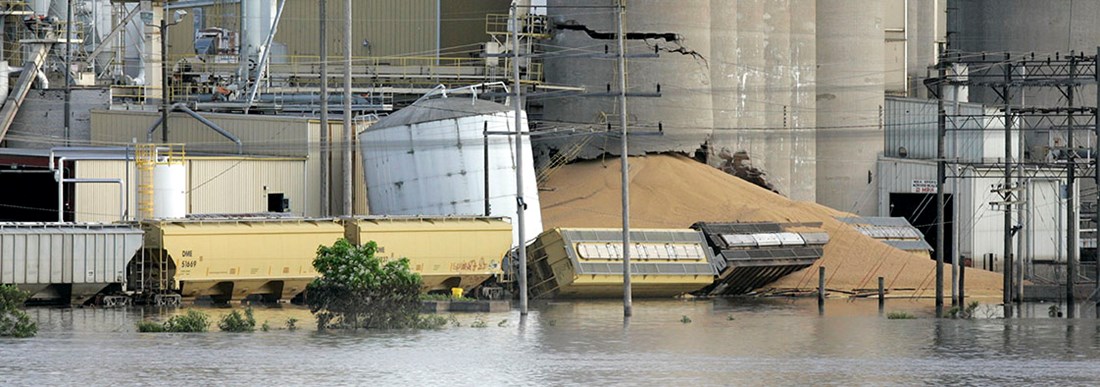Is the website displaying in the correct language? Please confirm or select a different language.
Your region has been set automatically. Please confirm or select a different region.

The 2nd 500-year Flood
The Cedar River has been threatening to flood the city of Cedar Rapids, Iowa, as long as anyone can remember. Some years the river rose to record levels but earthen levees and flood walls kept the Cedar mostly within the banks of its tight S curve through the city.
At 9:20 a.m. on Wednesday, June 11, the National Weather Service reported that the Cedar River reached a record 20.01 feet in Cedar Rapids. The old record of 20 feet was reached in 1929, and thought to have also been reached in 1851. The weather service jumped its forecast for the Cedar Rapids crest expected on Friday from 22.1 feet to 24.5 feet, two feet below the projected "500-year flood" crest.
Cedar Rapids city officials expanded the mandatory evacuation area to match the 500-year flood map. Police officers stood in knee-deep water as they unsnarled backed-up traffic attempting to cross the First and Second Street bridges before they were closed or inundated. Railroad cars filled with rock ballast were parked atop a bridge just south of downtown to try to prevent the river from carrying the span away.
Thursday morning, the bridge lay toppled on its side, white water rushing over the girders. People could be seen dragging suitcases up closed highway exit ramps to escape the water.
One resident reported brown flood water lapping at the edge of her backyard at 11 a.m. and by 3:30 p.m. the basement was inundated and the pressure of the water had cracked the foundation.
By Thursday afternoon, the Cedar River was 29 feet deep, or 17 feet above flood stage. Brian Pierce, a meteorologist with the National Weather Service in Davenport, said, "We’re in uncharted territory — this is an event beyond what anybody could even imagine."

Finally, on Friday the 13th, the Cedar crested at Cedar Rapids at 31.12 feet, a stunning 11.12 feet of petroleum- and garbage-polluted water above the previous flood of record set in 1929 and 19.12 feet above flood stage. Most of downtown Cedar Rapids was underwater, including city hall and the county courthouse and jail, all built on an island in the middle of the river.
At the Cargill corn processing plant spread out along the south side of the river, the floodwaters were rushing through the silos, bins and buildings, sweeping heavy equipment along with the surge. By Sunday, the Cedar had receded five feet but it would be three more days before the river dropped enough so crews could begin pumping water, and another week before the river fell below flood stage.
With the Cargill corn milling facility closed, the company was forced to declare "force majeure" on corn syrup contracts. This means the company would not be able to meet all of its customers’ contract volumes, and supply of corn syrup would be limited until the situation was resolved. Resolving the situation started with mucking out the mess.
Cargill had seven or eight platform scales and a 72 ft x 10 ft rail scale about six feet underwater. They called Keith Elson, proprietor of Aaron Scale Systems, a Rice Lake customer since the days of Thomas & Johnson Scale Service. Keith recalls, "When the water receded, the state commissioner wouldn’t allow Cargill to repair the track scale. They had to replace it. And they needed it replaced quickly. They had tons of damaged corn fructose on the property that had to come out by rail cars, and the product had to be weighed for insurance purposes. They were working day and night."
As soon as the water receded, Brice LaGrange, Keith’s grand-daughter’s husband, and his crew, installed two temporary SURVIVOR® pitless truck scales in 24 hours. The rail scale would take longer. Brice’s crew had plenty to do. "First we had to tear out parts of the old foundation. We used M4 concrete, which dries in twenty-four hours, for the new foundation components. It’s the concrete Iowa uses for bridges."
Keith remembers the stress, "We had this high-power concrete in the mixer truck, and we had forty-five minutes before it started to set. Then the mixer truck ran into a huge traffic jam because there was only one bridge open. We had to go twenty miles out of the way to get to the Cargill site. But we made it."
Subscribe to Rice Lake Magazine
Sign in or create a Rice Lake website account to request a Rice Lake Magazine filled with application stories like this one be sent to you.
Account Sign In Create an Account


 My Account
My Account